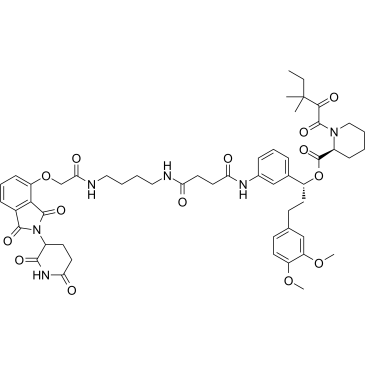dFKBP-1 |
| Catalog No.GC60133 |
dFKBP-1 is a potent and PROTAC-based FKBP12 degrader. dFKBP-1 incorporates the ligand SLF of FKBP12, the Thalidomide based Cereblon ligand and a linker.
Products are for research use only. Not for human use. We do not sell to patients.

Cas No.: 1799711-22-0
Sample solution is provided at 25 µL, 10mM.
dFKBP-1 is a potent and PROTAC-based FKBP12 degrader. dFKBP-1 incorporates the ligand SLF of FKBP12, the Thalidomide based cereblon ligand and a linker[1].
dFKBP-1 potently decreases FKBP12 abundance in MV4;11 cells, leading to over 80% reduction of FKBP12 at 0.1 μM and 50% reduction at 0.01 μM. As with dBET1, destabilization of FKBP12 by dFKBP-1 is rescued by pre-treatment with Carfilzomib, MLN4924, free SLF or free Thalidomide. Cereblon (CRBN)-dependent degradation is established using previously published isogenic 293FT cell lines which are wild-type (293FT-WT) or deficient (293FT-CRBN-/-) for CRBN. Treatment of 293FT-WT cells with dFKBP-1 induces potent, dose-dependent degradation of FKBP12, whereas 293FT-CRBN-/- are unaffected[1].
[1]. Winter GE, et al. DRUG DEVELOPMENT. Phthalimide conjugation as a strategy for in vivo target protein degradation. Science. 2015 Jun 19;348(6241):1376-81.
Average Rating: 5 (Based on Reviews and 3 reference(s) in Google Scholar.)
GLPBIO products are for RESEARCH USE ONLY. Please make sure your review or question is research based.
Required fields are marked with *




















